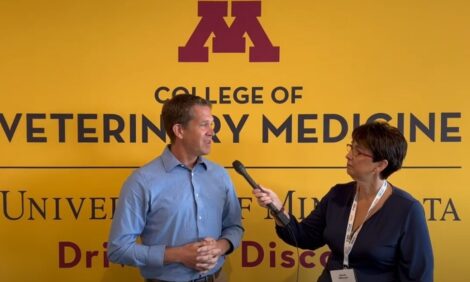



Decontamination protocols fail to disinfect incoming hog supplies
Biosecurity protocols are critical to keeping the US hog herd healthy, and one of the regular tasks is to disinfect a wide range of supplies entering the farm. It’s well documented that any number of pathogens can hitch a ride on products, packaging, tools and other supplies. As a result, disinfection rooms are now commonplace within hog production sites. But the question remains: How effective are those rooms and protocols?
That’s what Kristen Leuck, veterinary student at the University of Illinois, set out to determine in her research as part of the Iowa State University Swine Veterinary Internship Program. Specifically, she evaluated the surface-area coverage of a disinfectant applied with automatic and manual foggers.
“Just how low the coverage that we were achieving was the scariest thing to me,” Leuck told Pig Health Today. “The ability of our foggers to adequately cover our materials is a lot lower than we had originally presumed.”
Replicating the real world
For the study, Leuck used a fumigation room within a commercial sow farm that had a three-tier wire shelving unit located along one wall and a ventilation fan to exhaust air following the disinfection process. Two common automatic foggers and a manual-pump sprayer were used to apply the disinfectant Intervention according to the manufacturer’s recommended 1:16 dilution. She set up four test combinations:
- A single Fogmaster® 5330, which is an automated fogger with a stationary neck piece that emits the disinfectant at a fixed angle.
- A single Hurricane Ultra II automated fogger with a tilt-locking neck that allows the spray angle to be adjusted.
- Two Hurricane Ultra II foggers positioned in two different locations within the room.
- A Chapin 20003, 3-gallon, manual-pump garden sprayer.
Leuck used four new, white cardboard boxes to mimic typical supply boxes in each trial. She added purple clothing dye to visually measure disinfectant coverage and used a software program to more precisely evaluate the percent of surface area covered. In all cases, a 10-minute contact time was allowed to mimic on-farm practices.
The foggers fell short
For the Fogmaster, the results showed only 25% coverage. “Essentially, only the top of our boxes was covered with a little bit of disinfectant,” Leuck noted.
The single Hurricane fogger recorded 30% to 35% coverage, which increased to about 55% with two Hurricane foggers.
Variations in room size and fogger location may influence the results to a degree. “But consistently the message is that our automated foggers aren’t getting as good of coverage as we originally thought,” she said. The original assumption was that foggers applied a mist within the room that would permeate surfaces throughout the room, including around the supplies. But this and other studies have revealed that is not what’s happening.
The manual sprayer performed substantially better, providing nearly 95% coverage. The final 5% was a result of not moving the boxes on the shelves for better coverage during spraying.
One of the downfalls to a manual sprayer is that it’s more time-consuming. “It also sprays at a higher flow rate, so you could be very wasteful with products,” Leuck noted. “We need to work toward creating some good protocols for what we need to be doing on our farms.”
Fumigation-room recommendations
After having observed a variety of fumigation rooms Leuck has identified some consistent oversights. Following are five recommendations she has to improve fumigation room effectiveness:
- Select the right disinfectant for your herd’s needs. Make sure that disinfectant reservoirs are full and that products are measured to the proper concentration rate.
- If possible, remove the outer packing from supplies that arrive to the farm. This will allow the disinfectant to contact the actual supply surface. Also, past research has shown that chemical disinfection is ineffective on cardboard no matter the process.
- Do not overcrowd the fumigation room; the disinfectant needs to be able to reach all surfaces. Wire shelving best accommodated coverage.
- Never use the fogging room or chamber for storage.
- Monitor supplies and schedule deliveries with the disinfection process in mind. You don’t want to skip or rush this biosecurity step.
“Our recommendation is, if it’s possible and affordable, to manually spray supplies entering,” she added. “We want 100% coverage for our supplies to be thoroughly decontaminated.”
While chemical disinfectants are commonplace today, other techniques and materials are coming into play, such as UV radiation, time and temperature, and gas. Leuck advised producers and veterinarians to “continually look into options and what a combination of these, with our chemical disinfectants, can do for our biosecurity procedures.”






